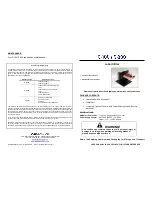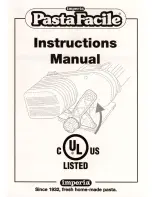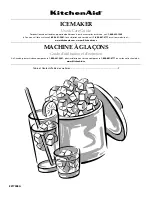
Page 7
Digital Bread Maker
Cleaning
Disconnect the Bread Maker from the power and allow to cool before cleaning.
1.
Rotate the Bread Pan
3
counterclockwise to unlock (see diagram). Lift out of the Bread Maker
1
.
2.
Hold the Kneading Blade
4
firmly and pull upwards to remove it from the spindle in the centre of
the Bread Pan
3
.
•
If the Kneading Blade is difficult to remove, fill the Bread Pan with hot water and allow to soak for
about 30 minutes.
3.
Wash the Bread Pan
3
and Kneading Blade
4
in warm water and detergent or washing-up
liquid. Do not use any harsh or abrasive cleaning materials. Both these items are dishwasher safe.
4.
Wash the Cup
5
,Spoon
6
and Hook
7
in warm water and detergent or washing-up liquid. Do
not use any harsh or abrasive cleaning materials.
5.
Wipe the Bread Maker Body
1
and Lid
2
with a cloth, slightly dampened with warm water and
detergent. Do not use any abrasive cleaning materials.
6.
Dry all parts thoroughly before storing, when the lid should be left closed.
Ingredients
This section introduces the main ingredients used in baking bread and making yogurt and how to
measure them. Exact instructions will be found in your recipe book or the ingredient packet.
Measuring Ingredients
The quantity of ingredients you use is very important to achieving good results. To assist in this,
both a Measuring Cup
5
, which is graduated in liquid ounces, millilitres and fractions of a cup,
and a Measuring Spoon
6
, which has a teaspoon and tablespoon measure.
Water, other liquids and larger quantities of dry ingredients such as flour should be measured
using the Measuring Cup
5
; ensure you are viewing the cup horizontally. Wash the cup thoroughly
between ingredients other than water.
Smaller quantities should be measured using the Measuring Spoon
6
.
Ensure that measured dry powder ingredients are level with the rim of the spoon, for example with a
knife blade. Store such ingredients in cool and dry conditions, loosely packed.
THE MAXIMUM QUANTITY OF FLOUR IS 4 CUPS. THE MAXIMUM QUANTITY OF YEAST IS 3
TEASPOONS.
Adding Ingredients
It is important to add ingredients in the correct sequence, as applicable:
Usually, water or other liquid should be added first, then eggs, followed by sugar, salt and flour,
then yeast or baking powder as the last ingredient. An exception to this is heavy dough with high
rye or wholemeal content, in which case it is advisable to add yeast, then other dry ingredients first,
then liquid ingredients. This will give better results from kneading.
Do not allow yeast to come into contact with liquid or salt whilst adding ingredients. This requires
that some flour is kept dry to allow yeast to be added. To add yeast, first make a small indentation in
a dry area of flour, then add the yeast to the indentation.
Additional fruit ingredients, such a raisins, should not be included with the original ingredients, as
they can lose flavour during mixing. During the following programmes, a series of 10 short “beeps”
will sound to indicate that additional ingredients can be added:
•
Basic
•
French
•
Whole Wheat
•
Sweet
•
Sandwich.






























